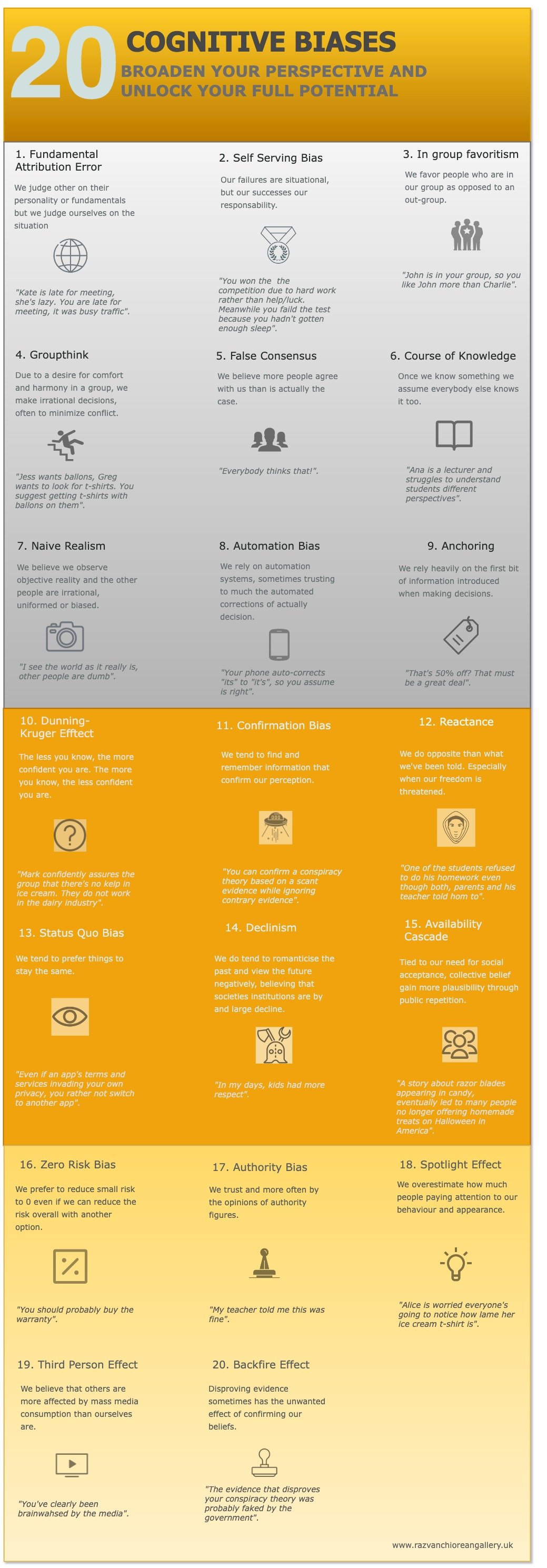MIND, LEARN
3D visualisations by Novoto Studio as part of the Visualising AI project launched by Google DeepMind
Welcome to the world of cognitive biases, where your mind can play tricks on you without you even realizing it. From the way we perceive information to the decisions we make, cognitive biases have a profound impact on our daily lives. In today's society we're constantly bombarded with information from social media, news outlets and advertisements.
It's more important than ever to understand these biases and how they shape our beliefs and behaviors. This post will explore some of the most common cognitive biases that affect people nowadays and how you can recognize and overcome them to make more informed decisions. So sit back and get ready to challenge your thinking as we delve into the fascinating world of cognitive biases.
What is a bias?
Bias is a disproportionate weight in favor of or against an idea, usually in a way that is closed-minded, prejudicial or unfair.
~Wikipedia
Recognizing Cognitive Biases
Cognitive biases are inherent flaws in human thinking that can affect our perceptions, judgments, and decision-making abilities. They are often caused by factors such as our personal experiences, social influence, and the limitations of our cognitive processing.
5 Ways to Spot Cognitive Biases And Make Smarter Decisions
1. Understand what cognitive biases are
The first step in recognizing cognitive biases is to understand what they are and how they work. There are many types of cognitive biases and each one can impact our thinking in different ways. Some common examples include confirmation bias, where we seek out information that confirms our existing beliefs, and the halo effect, where we judge people based on a single characteristic or trait.
2. Be aware of your own biases
It's important to recognize that everyone has cognitive biases and we all see the world through our own unique lens. By becoming aware of our own biases, we can start to recognize them in others and in society as a whole. It can be helpful to reflect on your own thinking and identify any patterns or tendencies that may be influenced by bias.
3. Look for patterns in media and messaging
The media and other messaging can often be influenced by cognitive biases, whether intentionally or unintentionally. Look for patterns in the way that information is presented or framed, and try to identify any underlying biases. For example, a news story that consistently portrays one political party in a negative light may be influenced by confirmation bias.
4. Seek out diverse perspectives
Exposure to a diverse range of perspectives and ideas can help to counteract the influence of cognitive biases. Seek out sources of information that challenge your existing beliefs and assumptions and try to keep an open mind. Engaging in conversations with people who have different viewpoints can also be helpful in identifying your own biases and recognizing biases in others.
5. Educate yourself
Finally, it's important to continue learning about cognitive biases and the ways in which they can impact our thinking. There are many resources available online and in print that can provide insights into cognitive biases and how to recognize them. By staying informed, you can better navigate the complex world around you and make more informed decisions.
Overcoming cognitive biases can be challenging, but here are some strategies that can help:
• Engage in critical thinking: Critical thinking involves questioning assumptions, analyzing evidence, and evaluating arguments. By engaging in critical thinking, you can learn to challenge your own biases and make more objective decisions.
• Slow down and reflect: Many cognitive biases are the result of quick, automatic thinking. By slowing down and reflecting on your thoughts and feelings, you can gain a better understanding of your biases and make more thoughtful decisions.
• Use decision-making frameworks: Decision-making frameworks, such as cost-benefit analysis, can help you make more objective decisions by weighing the pros and cons of different options.
• Practice mindfulness: Mindfulness involves being aware of your thoughts and feelings without judgment. By practicing mindfulness, you can learn to observe your biases and make more intentional decisions.
The bottom Line
Remember, overcoming cognitive biases is a process that takes time and practice. By being aware of your biases and taking steps to challenge them, you can make more objective and informed decisions. The presence and influence of cognitive biases in our society cannot be ignored or underestimated.
As we continue to navigate a rapidly changing world filled with endless information and new challenges, it is important to acknowledge, understand and actively combat these biases in ourselves and in our communities.
By doing so, we can work towards creating a more just, equitable and empathetic society that values objective reasoning and critical thinking over subjective opinions and preconceived notions. The future of humanity may well depend on our ability to overcome our own cognitive limitations and biases and it is up to each and every one of us to rise to the challenge.
Do you ever feel biased about any particular aspect in your life? Share your experience about it in a comment bellow and let’s grow together!
✩✩✩
The Ribble CGR SL is the ultimate in lightweight, high performance, rugged and versatility
















Learn how to navigate the challenges of open water and boost your performance in triathlon events.